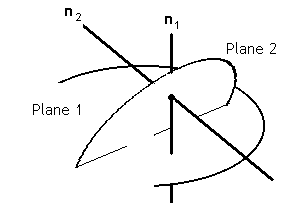Problem: |
||
| A diagram of this is shown on the right. |  |
By simple geometrical reasoning; the line of intersection is perpendicular to both normals. |
| To find the position vector, r, of any point on the line of intersection; find a vector, v, to which the line is parallel, find the position vector, a, of specific apoint on the line, then; r = a + tv, is the required result. |
To find v; the cross product of two vectors gives a third vector which is perpendicular to both vectors. v is perpendicular to both therefore, v will beparallel to From the equations to the planes, therefore = ![[Graphics:Images/index_gr_13.gif]](Images/index_gr_13.gif) = = [12, -9, 9] 1. To find a; at any point on the line the position vector, let the point be (x, y, z), then; From the equations to the planes, (x, y, z) . [3, 4, 0] = 5 and (x, y, z) . [1, 2, 3] = 6 3x + 4y = 5 and x + 2y + 3z = 6 Let the point have an x co-ordinate = 0 then; y = a is therefore [ 0, Substituting result 1. and 2. into r = a + tv gives; r = [ 0, or, more simply, r = [ 0, since the vector [12, -9, 9] is parallel to [4, -3, 3] |
|